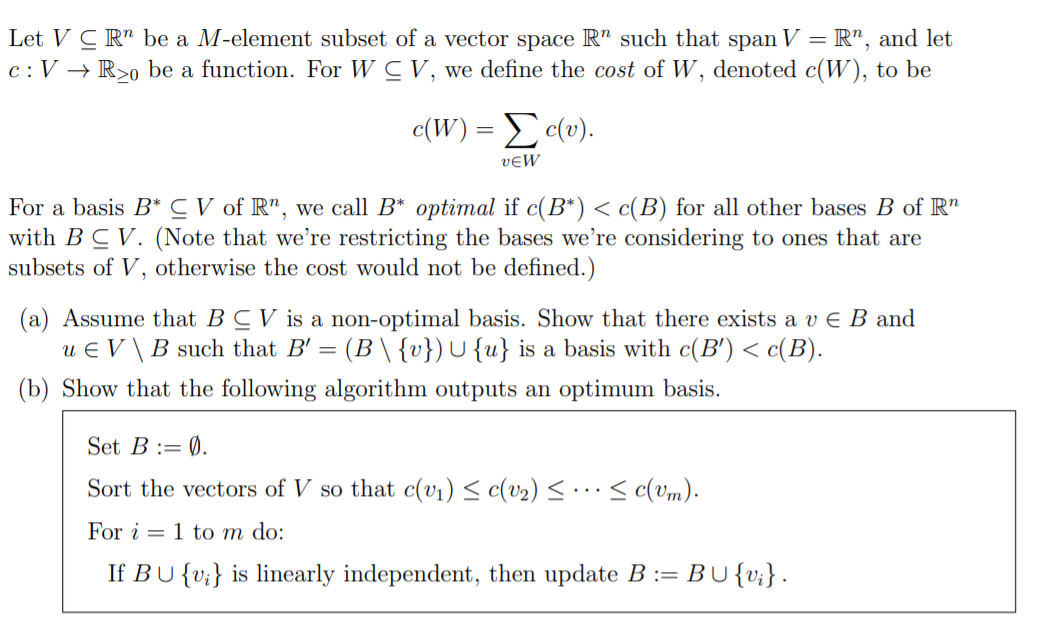Let V C R" be a M-element subset of a vector space R" such that span V = R", and let c :V → R>o be a function. For W C V, we define the cost of W, denoted c(W), to be CW) Σε(ν). vƐW For a basis B* CV of R", we call B* optimal if c(B*) < c(B) for all other bases B of R" with B C V. (Note that we're restricting the bases we're considering to ones that are subsets of V, otherwise the cost would not be defined.) (a) Assume that BC V is a non-optimal basis. Show that there exists a v E B and u e V \ B such that B' = (B \ {v}) U {u} is a basis with c(B') < c(B).
Let V C R" be a M-element subset of a vector space R" such that span V = R", and let c :V → R>o be a function. For W C V, we define the cost of W, denoted c(W), to be CW) Σε(ν). vƐW For a basis B* CV of R", we call B* optimal if c(B*) < c(B) for all other bases B of R" with B C V. (Note that we're restricting the bases we're considering to ones that are subsets of V, otherwise the cost would not be defined.) (a) Assume that BC V is a non-optimal basis. Show that there exists a v E B and u e V \ B such that B' = (B \ {v}) U {u} is a basis with c(B') < c(B).
Linear Algebra: A Modern Introduction
4th Edition
ISBN:9781285463247
Author:David Poole
Publisher:David Poole
Chapter6: Vector Spaces
Section6.4: Linear Transformations
Problem 34EQ
Related questions
Topic Video
Question
Show the details please.

Transcribed Image Text:Let V C R" be a M-element subset of a vector space R" such that span V = R", and let
c:V → R>o be a function. For W CV, we define the cost of W, denoted c(W), to be
c(W) = c(v).
vɛW
For a basis B*C V of R", we call B* optimal if c(B*) < c(B) for all other bases B of R"
with B C V. (Note that we're restricting the bases we're considering to ones that are
subsets of V, otherwise the cost would not be defined.)
(a) Assume that BC V is a non-optimal basis. Show that there exists a v E B and
u e V\B such that B' = (B \ {v}) U {u} is a basis with c(B') < c(B).
(b) Show that the following algorithm outputs an optimum basis.
Set B := Ø.
Sort the vectors of V so that c(v1) < c(v2) < · · < c(Um).
For i = 1 to m do:
If BU {v;} is linearly independent, then update B :=
BU{v;}.
Expert Solution
This question has been solved!
Explore an expertly crafted, step-by-step solution for a thorough understanding of key concepts.
Step by step
Solved in 2 steps

Knowledge Booster
Learn more about
Need a deep-dive on the concept behind this application? Look no further. Learn more about this topic, advanced-math and related others by exploring similar questions and additional content below.Recommended textbooks for you

Linear Algebra: A Modern Introduction
Algebra
ISBN:
9781285463247
Author:
David Poole
Publisher:
Cengage Learning

Elementary Linear Algebra (MindTap Course List)
Algebra
ISBN:
9781305658004
Author:
Ron Larson
Publisher:
Cengage Learning

Linear Algebra: A Modern Introduction
Algebra
ISBN:
9781285463247
Author:
David Poole
Publisher:
Cengage Learning

Elementary Linear Algebra (MindTap Course List)
Algebra
ISBN:
9781305658004
Author:
Ron Larson
Publisher:
Cengage Learning